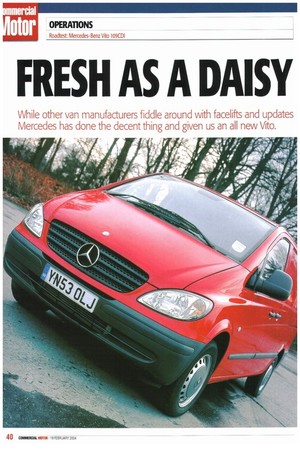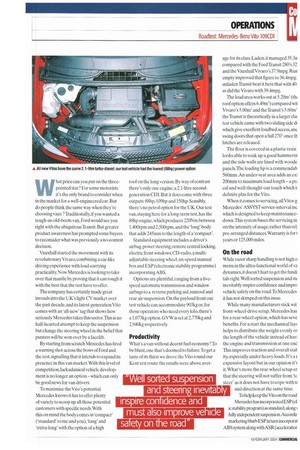FRESH AS A DAISY
Page 42

Page 43

Page 44

If you've noticed an error in this article please click here to report it so we can fix it.
While other van manufacturers fiddle around with facelifts and updates Mercedes has done the decent thing and given us an all new Vito.
What price can you put on the threepointed star? For some motorists it's the only brand to consider when in the market for a well-engineered car. But do people think the same way when they're choosing vans ? Traditionally, if you wanted a tough-as-old-boots van, Ford would see you right with the ubiquitousTransit.But greater product awareness has prompted some buyers to reconsider what was previously a no-contest decision.
Vauxhall started the movement with its revolutionary Vivaro, combining a car-like driving experience with load-carrying practicality. Now Mercedes is looking to take over that mantle by proving that it can rough it with the best that the rest have to offer.
The company has certainly made great inroads into the UK's light CV market over the past decade. and its latest-generation Vito comes with an 'all-newtag that shows how seriously Mercedes takes this sector.This is no half-hearted attempt to keep the suspension but change the steering wheel in the belief that punters will be won over by a facelift.
By starting from scratch Mercedes has tired a warning shot across the bows of Ford and the rest.signalling that it intends to expand its presence in this van market. With this level of competition, lackadaisical vehicle development is no longer an option— which can only be good news for van drivers.
To maximise the Vito's potential Mercedes knows it has to offer plenty of variety to scoop up all those potential customers with specific needs.With this on mind the body comes in 'compact' ('standard' to me and you).`long' and 'extra-long' with the option of a high roof on the long version. By way of contrast there's only one engine :a 2.1-litre secondgeneration CD I.But it does come with three outputs: 88hp,109hp and 150hp. Sensibly. there's no petrol option for the UK. Our test van, staying here for a long-term test, has the 88hp engine, which produces 220Nm between .400rpm and 2,500rpm. and thelong' body that adds 245mm to the length of a `compact'.
Standard equipment includes a driver's airbag. power steering, remote central locking, electric front windows, CD-radio, a multiadjustable steering wheel, six-speed manual box and ESP (electronic stability programme) incorporating ABS.
Options are plentiful. ranging from a livespeed automatic transmission and window airbags to a reverse parking aid, sunroof and rear air suspension. On the payload front our test vehicle can accommodate 903kg or, for those operators who need every kilo,there's a I ,073kg option. G V W is set at 2,770kg and 2.940kg respectively.
Productivity
What's a van without decent fuel economy? To be blunt,one that's doomed to failure.To get a taste of its thirst we drove the Vito round our Kent test route: the results were above aver age for its class. Laden. it managed 35.3n compared with the Ford Transit 280's 32 and the Vauxhall Vivaro's 37.9mpg. Run empty improved that figure to 36.4mpg. unladen Transit beat it here that with 40. as did the Vivaro with 39Ampg.
The load area works out at 5.20m1(thi roof option offers 6.49m3) compared wii Vivaro's 5.00mR and the Transit's 5.60m; theTransit is theoretically in a larger cla; test vehicle came with two sliding side dl which give excellent loadbed access, anC swing doors that open a full 270° once th latches are released.
The floor is covered in a plastic resin looks able to soak up a good hammerin and the side walls are lined with woode panels. The loading lip is a commendab 560mm. An under-seat area adds an exl 200mm to maximum load length — a pn cal and well-thought-out touch which I: definite plus for the Vito.
When it comes to servicing, all Vitas g Mercedes' ASSYST service-interval inc which is designed to keep maintenance down.This system bases the servicing in on the intensity of usage, rather than ret pre-arranged distances. Warranty is for years or 125,000 miles.
On the road
While razor sharp handling is not high o menu in the ultra-functional world of va dynamics, it doesn't hurt to get the fund; tals right.Well sorted suspension and su inevitably inspire confidence and imprc vehicle safety on the road.To Mercedes it has not skimped on this issue.
While many manufacturers stick wit front-wheel-drive setup, Mercedes has for a rear-wheel option, which has seve benefits. For a start the mechanical lay( helps to distribute the weight evenly ON the length of the vehicle instead of havi the engine and transmission at one end This improves traction and overall stat ity, especially under heavy loads. It's a expensive layout but in our opinion it's it.What's more the rear-wheel setup er that the steering will not suffer from "tc steer' as it does not have to cope with ti and direction at the same time.
To help keep the Vito on the road Mercedes has incorporated ESP (el ic stability program) as standard, along) fully independent suspension.Accordir marketing blurb ESP in turn inoorporai ABS system along withASR (acceleratior control).EBV (electronic brake force) distribution and BAS (brake assist system).See page 5810 read of ESPin action.According to Mercedes,the result of all this is that directional stability and traction are improved,along with a useful reduction in braking distances.
Sounds good, but how does all this technology affect the driving experience? Well, without getting carried away, the Vito has to be up there with the best when it comes to road manners. Overall solidity is as we've come to expect from this marque,but what stands out are its composure and body control.
On A-roads and motorways it cruises effortlessly. feeling more like a well sorted saloon car than a workaday panel van. Crosswind interference is minimal and the suspension absorbs road imperfections with aplomb. Around town it seems to shrink in size. letting you slot into spaces and manoeuvre around obstacles with ease. Steering is surprisingly communicative with a good degree of weighting and the gearchange is light and precise.All this adds up to an enjoyable drive that inspires confidence.
On the downside, well we couldn't let them get away without at least one or two cornments,the door mirrors could be a bigger and a blindspot lens would be nice. On a more serious point, the engine could be a tad more refined. Whether it was the lack of a bulkhead that exaggerated the noise and vibration we don't know, but there are smoother engines out there.
Cab comfort
It may be predominantly grey, but the interior of the Vito hits all the right notes... nearly. More car than van-like, it has a cosseting feel that is far removed from most other van interiors and the overall clarity of the controls adds to this elevated status.
Let's start with the driving position. While some vans make you feel like you're driving, well, a van, the Vito offers a lower.more relaxed layout. Feet can slide forward to the pedals with ease as opposed to the 'sit-up-andbeg' feeling that comes with plenty of its rivals. Central instrumentation is good with a central speedo flanked by temperature and fuel dials.
Finding a decent driving position is easy with the multi-adjustable seat and steering wheel.The seat itself is top-notch, providing excellent support on a 400-mile round trip with no sign of the usual 100-mile ache.
One gripe we do have in such a well thought out interior is the lack of any deep storage compartments and only one cup-holder. Ok, it's picky, but if it struck us as a slight let-down then we're sure we won't be alone. What the Vito does have is an excellent A4 folder compartment above the central console,door bins that cater for a large water bottle (but are generally a bit on the thin side) and several small-change/mobile-phone cubby holes.
Unlike its bigger brother, the Sprinter.the Vito sports Merc's car-derived single stalk to operate the indicators and wipers. It's complicated at first for those of you who don't own an EClass, but after a while it becomes second nature.The standard CD player is easy louse and all secondary controls such as the heater system are clearly laid out.
Forward visibility is good too, with the sloping windscreen letting in plenty of light. A n extra glass area below the A-pillar gives the Vito an individual touch and helps to add to the overall feeling of cabin space. •






































































































































































































